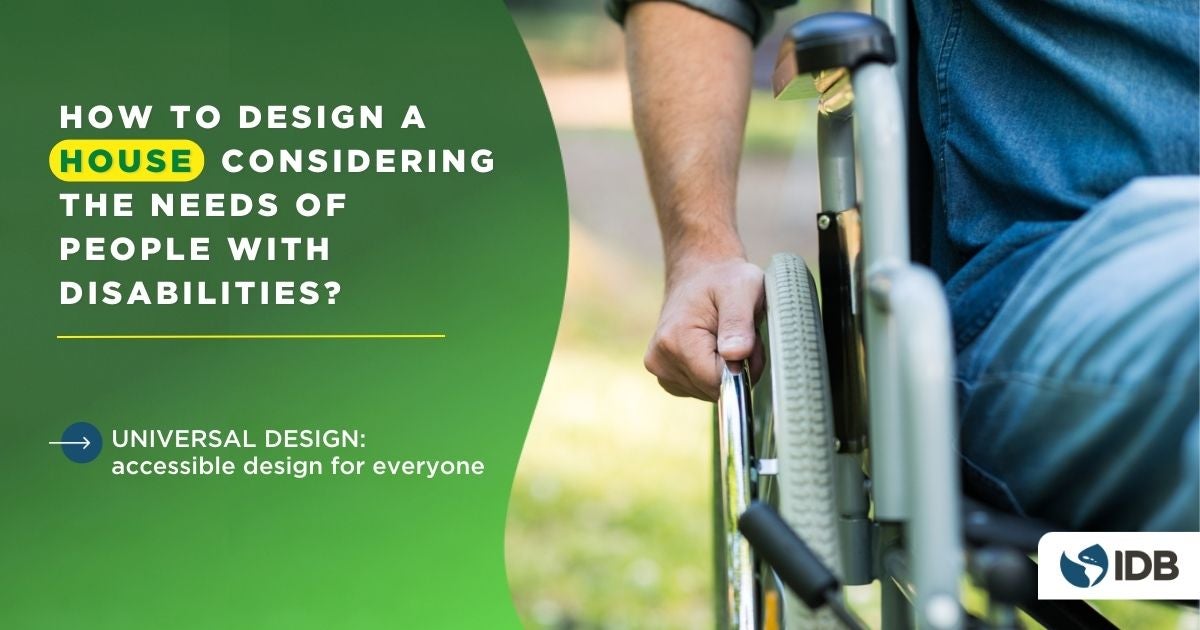Este artículo está también disponible en / This post is also available in: Spanish
Every day, many people find it difficult to move around their city, use public transportation, enter a building and even move independently in their own homes. Do you know why? Because the majority of public and private spaces are not accessible for people with disabilities.
Building a housing stock that adapts to the needs of people with disabilities not only promotes independence and equality for all but also responds to an important segment of the housing market that is experiencing rapid growth. In Latin America and the Caribbean (LAC), close to 100 million people have some form of disability (more than the population of Argentina and Peru combined). This number is likely to increase as the percentage of residents over the age of 65 rises, making it necessary to create housing that is inclusive and adapted to the needs of all its residents.
At the Housing and Urban Development Division of the Inter-American Development Bank (IDB), we are committed to promoting inclusive cities for all . That is why we support the and construction of housing that can serve the needs of everybody, including people of all abilities. In today’s article, we will highlight some of the elements that must be considered when designing affordable housing adapted for people with disabilities and illustrate these concepts showing how the IDB is supporting universal housing standards in Ecuador. Don’t miss it!
Universal Design: accessible and inclusive design
Universal design aims to create environments that are usable by all people, regardless of age or level of ability. By integrating universal design principles into affordable housing policies, we can ensure that subsidized housing is accessible to the majority of the population it is intended to serve. This will be beneficial to the society as a whole, as a stronger and more inclusive housing market is fostered. How can we include the principle of universal design in affordable housing policies?
1) Consider the dimensions of the entrance and internal circulation of the dwelling:
Ensure that doorways and hallways allow for wheelchair passage and eliminate steps. If this is not possible throughout the whole layout of the dwelling, at least allow a connection between the entrance, common spaces, a bedroom, and a bathroom.

Example of housing conceived taking into account universal design criteria | Source: MIDUVI Ecuador
2) Choose interior materials and elements carefully:
Non-slip floor materials, grab bars and roll-in showers improve accessibility and ease of use for people with mobility limitations and reduce the burden of care for the entire household Install easy-to-operate doorknobs, switches, and faucets.
3) Incorporate outdoor spaces into the design:
Creating accessible housing goes beyond interior spaces. Pathways and landscaping should have gentle slopes and handrails to make it easier for people with reduced mobility to navigate. If possible, provide opportunities to connect with nature and greenery, which awaken a range of senses and provide opportunities for enjoyment for all.
4) Use financial tools to promote universal design features.
Developers would be more inclined to produce universally accessible housing if there were some incentives to do so, such as special tax benefits, accelerated approval processes, or construction bonuses for those who offer them. Similarly, specific lines of credit at preferential rates could be made available to households with people with disabilities to facilitate their access to housing units.

Imágenes del edificio en Ambato, Ecuador, donde se llevará a cabo la rehabilitación | Source: MIDUVI Ecuador
How does the IDB support the creation of housing for people with disabilities?
In Ecuador, since July 2019, the IDB has been financing the “Housing Solutions for Poor and Vulnerable Households” program. This initiative, led by the Ministry of Urban Development and Housing of Ecuador (MIDUVI), aims at inclusion through the granting of housing subsidies to low-income and vulnerable households. Subsidies may cover the construction of a housing unit in rural areas, or provide a support purchasing a home in urban areas.
The Program, still under implementation, has an inclusive approach and prioritizes the attention to families with people with disabilities (almost 18% of the subsidies). By June 15, 2023, this program has delivered nationwide about 2,259 houses, of which 404 went to families that have among its members a person with a disability. The homes are two-bedroom homes, with a floor area of 51 m2, or 3-bedroom homes, with a floor area of 57 m2. In both cases, they have universal accessibility elements, such as wider corridors and access ramps.
In its efforts to provide solutions to families in need, last year MIDUVI, with the collaboration of the IDB, started a pilot program to rehabilitate and recover State owned buildings that are underutilized, to convert them into social housing, under the social lease management model. In particular, a building built forty years ago in the city of Ambato, owned by MIDUVI, will be redeveloped following universal design standards. The architectural firm in charge of this project, Rama Studio, was selected through an open architectural design competition.
Some of the main beneficiaries of this initiative will be single mothers, people with disabilities, senior citizens, elderly people, children and adolescents, pregnant women, people with highly complex diseases, and victims of sexual or domestic violence.
Now it’s your turn!: let’s support housing policies for people with disabilities
Creating accessible housing for people with disabilities is an essential step toward building a more inclusive society. By applying the principles of universal design, ensuring outdoor accessibility, and providing specific financing tools, we can create homes that foster independence, promote a sense of belonging and improve the overall well-being of people with disabilities.
Housing policies in the region must integrate the principles of universal design for affordable housing. Designing for accessibility benefits everybody, not only people with disabilities. It fosters equality, social integration, and a more diverse and inclusive community. Architects, urban planners, and policymakers have a crucial role to play in promoting inclusive design practices and the rights of people with disabilities.


Leave a Reply